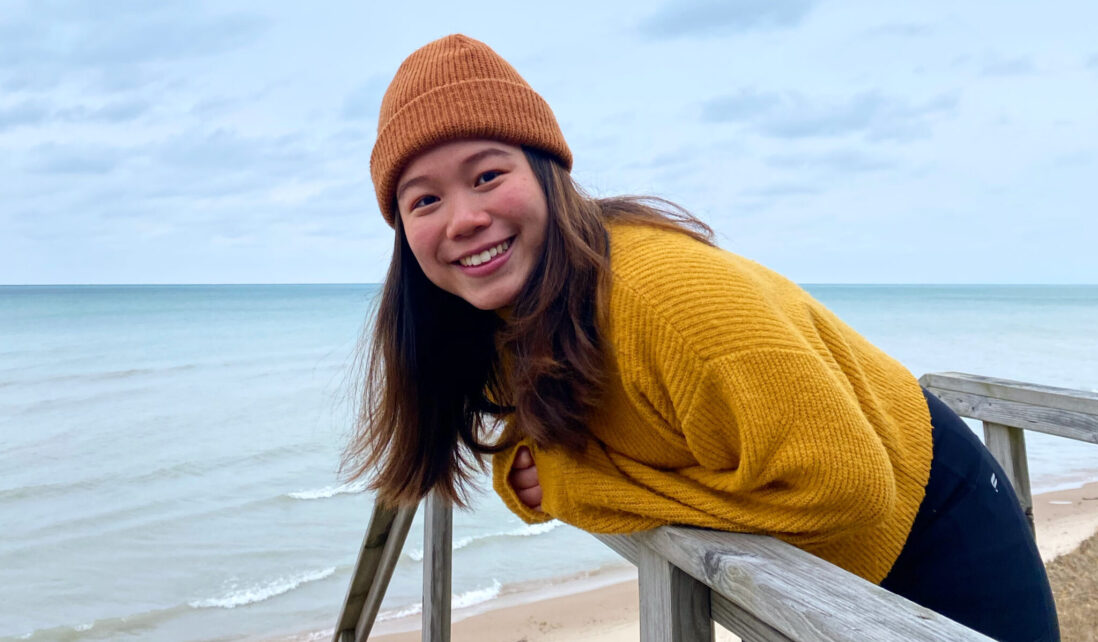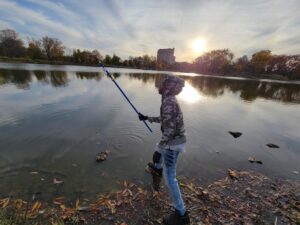
Meet Our Grad Student Scholars is a series from Illinois-Indiana Sea Grant (IISG) celebrating the graduate students doing research funded by the IISG scholars program. To learn more about our faculty and graduate student funding opportunities, visit our Fellowships & Scholarships page. Jin Yi (Jeanie) Tan is a second-year student in the Pharmaceutical Sciences Doctoral Program at the University of Illinois at Chicago (UIC). Her research is focused on developing an “environment to bioassay” antibiotic discovery approach while collaborating with local community centers—this is part of an educational effort to pair graduate-level research with outreach programs. As part of her work funded by Illinois-Indiana Sea Grant, she has also trained in scientific diving to explore the capacity of bacteria derived from Lake Michigan to produce new antibiotic sources.
Across the globe, superbugs—bacteria or fungi known to cause infections—are on the rise. The antimicrobial resistance crisis has become one of the most significant threats to public health. Without mobilized efforts to discover new antibiotics, the World Health Organization estimates about 10 million deaths related to antimicrobial resistance will occur per year by 2050.
To address this, graduate student Jin Yi (Jeanie) Tan is focused on finding novel drug-leads to combat multi-drug resistant bacteria by harnessing the power of their natural enemy: other bacteria. For millions of years, bacteria have fought one another with specialized chemical weapons. As a result of this evolutionary antagonism, microorganisms are a major source of antibacterial drugs.

Bacteria colonies that will be examined for potential antibiotic drug leads. Photo credit J. Tan.
Studying in the laboratory of Brian Murphy, a medical chemist at the University of Illinois at Chicago, Tan has been developing a new environment to bioassay antibiotic discovery approach using robotics to rapidly select, screen, and prioritize prolific antibiotic-producing bacteria from the environment. This approach streamlines the front-end of microbial drug discovery by enabling most steps to be performed in a semi-automated fashion. In fact, parts of the process were conceptually simple enough for Tan to be able to teach them to middle school students.
Through support as an Illinois-Indiana Sea Grant Graduate Student Scholar, Tan’s work builds on a current IISG-funded initiative led by Murphy. Tan’s research is integrated with an educational outreach program in partnership with local community centers to bridge the gap that exists between universities and their surrounding communities.
One such partnership is with the James Jordan Boys and Girls Club of Chicago, an organization in a near west side neighborhood that is home to over 32,000 Chicagoans and houses groups that are predominantly underrepresented in STEM. The afterschool program, Chicago Antibiotic Discovery Lab, brings students along for a practical learning experience while they hunt for antibiotics in their own neighborhoods. Lessons go beyond the classroom to ignite a sense of curiosity in students to engage in STEM, as well as provide exposure to careers in the environmental and biomedical sciences.

Students from the James Jordan Boys and Girls Club of Chicago meet the robot that will help pick their bacterial colonies. (Photo provided by Jin Yi “Jeanie” Tan)
So far, the program has led and educated 19 students (6th to 8th grade) in multiple steps of Great Lakes-based antibiotic discovery. They have engaged in three different local sample collections from both land and water environments, which included sediment, plants, and swabs of various surfaces. Students completed multiple tasks related to their samples—instilling a sense of ownership over their results—and performed applied science experiments in parallel with their mentors. This includes 1) growing bacteria, 2) programming a robot to isolate them by the hundreds/thousands, and 3) testing the ability of each one to inhibit the growth of deadly pathogens. The ultimate goal is to identify a new antibiotic from one of the bacteria.
Back in the lab, Tan is working on the top three samples that have shown promising growth inhibition against Staphylococcus aureus, a human pathogen well-known for causing life-threatening clinical infections. She is using a combination of chromatography and spectroscopy to identify novel antibiotics. Tan plans to publish her results and make a blueprint of the program available for others to create or improve similar university-community partnerships.
Besides the samples collected by her students, Tan is particularly interested in exploring aquatic bacteria to find new chemistry to combat infectious diseases. The Great Lakes serve as an excellent resource for this discovery effort, and chances of finding novel molecules is dependent on the biodiversity present in these aquatic ecosystems. As part of her training, she has been certified for underwater microbial sample collection by SCUBA and plans to perform scientific dive expeditions in various parts of Lake Michigan for antibiotic discovery.

A student from the James Jordan Boys and Girls Club of Chicago collects samples from local waterways.(Photo provided by Jin Yi “Jeanie” Tan)
“I’m excited to start scientific diving this summer and to share my experience with students,” said Tan. “By understanding the bio-assets from Lake Michigan and promoting scientific knowledge about bacteria and their essential roles in medicine, we want to bring a different perspective on why it is critical to protect the region’s biodiversity.”
Illinois-Indiana Sea Grant is a partnership between NOAA, University of Illinois Extension, and Purdue University Forestry and Natural Resources, bringing science together with communities for solutions that work. Sea Grant is a network of 34 science, education and outreach programs located in every coastal and Great Lakes state, Lake Champlain, Puerto Rico and Guam.
Contact: Carolyn Foley

